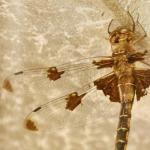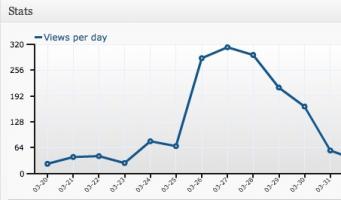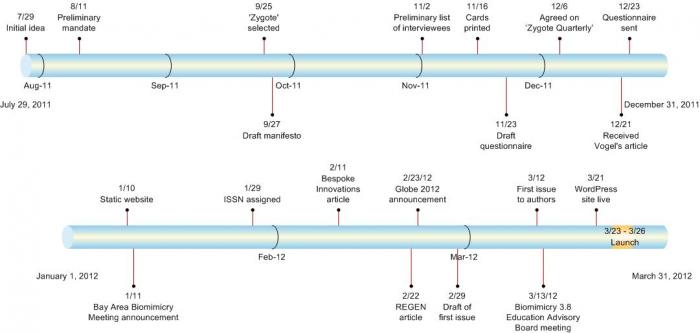The Story Behind Zygote Quarterly (Marjan Eggermont, Tom McKeag, Norbert Hoeller)
 The inaugural issue of ZQ was officially launched on March 23 to 26 through a wide range of channels, including LinkedIn groups, mailing lists, the BioInspired! site, and e-mails to key opinion leaders and an early Biomimicry Newsletter distribution list. The response has been gratifying:
The inaugural issue of ZQ was officially launched on March 23 to 26 through a wide range of channels, including LinkedIn groups, mailing lists, the BioInspired! site, and e-mails to key opinion leaders and an early Biomimicry Newsletter distribution list. The response has been gratifying:
- Fabulous story on Bespoke – like the other stuff too! (Andrée Iffrig)
- Interested in biomimicry? Check out this MUST SEE new online magazine devoted to the subject. It'll knock your socks off. (Cindy Gilbert)
- It absolutely is in a sweet spot and is a gorgeous, informative conduit to bigger and better biomimetic things to come! (Margo Farnsworth)
- It looks superb, the content is wide-ranging and well-chosen, and the overall intent of what you're doing is focused exactly where it's needed. (Paul Downton)
The journey began on July 29/2011 when Marjan suggested starting an online Biomimicry Journal, modeled on her Journal of Computational Media Design. The first conference call in August laid down the foundation of our enterprise: we wanted a visually exciting and credible quarterly journal that showcased the nexus of science and design, appealed to designers as problem solvers, and would attract the interest of key people in the field of biomimicry and bio-inspired design. Articles would be exemplary in their impact on the field, rigorous in their methodology and relevant to today’s reader. These initial ideas carried through to the final manifesto published in the first issue.
(right-click on the timeline to open a larger version in a new tab or window)
We were fortunate to have the support and insight of Steven Vogel from the very beginning. In April 2011, he had suggested to Tom and Norbert the value of a venue that brought together the practical perspectives of architects, engineers and other designers with biologists' functional understand of living models. Beyond facilitating the exchange of ideas, we could benefit from a structured way of editing, organizing and archiving information. Steven Vogel contributed the ZQ lead article When success fails on the challenges inventors face in achieving commercial success and included a tool for testing the viability of creative ideas.
 We wanted the journal to reveal the ‘people behind the news’. Marjan created a questionnaire that along with a personal invite were sent to thirty leaders in the field, covering a broad range of disciplines. Julian Vincent, Jay Baldwin, Maria Mingallon and Jane Fulton Suri responded with their impressions of the current state of biomimicry/bioinspired design, how they got started in the field and what they are currently working on. We are more than our work: the questionnaire also asked about favorite books and quotations, individuals they admired and their concepts of perfect happiness. Marjan edited their interviews into a fascinating series of articles.
We wanted the journal to reveal the ‘people behind the news’. Marjan created a questionnaire that along with a personal invite were sent to thirty leaders in the field, covering a broad range of disciplines. Julian Vincent, Jay Baldwin, Maria Mingallon and Jane Fulton Suri responded with their impressions of the current state of biomimicry/bioinspired design, how they got started in the field and what they are currently working on. We are more than our work: the questionnaire also asked about favorite books and quotations, individuals they admired and their concepts of perfect happiness. Marjan edited their interviews into a fascinating series of articles.
 Tom’s ongoing discussions with Scott Summit of Bespoke Innovations led to an article on the recent availability of design tools that can manipulate, simulate and analyze complex shapes and mathematical models, tasks that in the past required specialized expertise and massive computing power. These tools can directly drive 3D manufacturing machines that can form shapes previously impossible or prohibitively expensive using traditional manufacturing methods. The combination enables a process that "gives the client a satisfying natural contour to the prosthetic, a chance to be part of the design process and to express a positive individual style. A disability has been turned into an opportunity for very personal and beautiful design."
Tom’s ongoing discussions with Scott Summit of Bespoke Innovations led to an article on the recent availability of design tools that can manipulate, simulate and analyze complex shapes and mathematical models, tasks that in the past required specialized expertise and massive computing power. These tools can directly drive 3D manufacturing machines that can form shapes previously impossible or prohibitively expensive using traditional manufacturing methods. The combination enables a process that "gives the client a satisfying natural contour to the prosthetic, a chance to be part of the design process and to express a positive individual style. A disability has been turned into an opportunity for very personal and beautiful design."
 Norbert revisited the story of REGEN Energy and their EnviroGrid™ power controllers that use swarm logic to reduce peak load on the electrical grid while saving companies money. In spite of the skepticism of experts, the inventors were able to turn the concept of ‘distributed intelligence’ displayed by many social species into a commercially successful device that was inexpensive, adaptive, self-managing and delivered multiple benefits. Tom provided a sidebar that provided background on “eusocial insects”, emergence and “swarm logic”.
Norbert revisited the story of REGEN Energy and their EnviroGrid™ power controllers that use swarm logic to reduce peak load on the electrical grid while saving companies money. In spite of the skepticism of experts, the inventors were able to turn the concept of ‘distributed intelligence’ displayed by many social species into a commercially successful device that was inexpensive, adaptive, self-managing and delivered multiple benefits. Tom provided a sidebar that provided background on “eusocial insects”, emergence and “swarm logic”.
We used e-mail extensively to collaborate on the journal with conference calls every month or two when significant issues needed to be discussed. As the amount of content and the number of changes grew, Dropbox helped us keep track of the most current versions. Marjan integrated the text with stunning images into a visually pleasing layout using Adobe InDesign CS4. The ISSUU publishing system was selected to display the journal. Colin McDonald developed the website in WordPress, allowing direct access to ZQ, the ability to subscribe to our mailing list and the potential for supporting future content.
 ISSUU reports over 2,000 views while traffic on the WordPress site is over 1,250 cumulative views (see graph at right). Blogs that have mentioned ZQ include:
ISSUU reports over 2,000 views while traffic on the WordPress site is over 1,250 cumulative views (see graph at right). Blogs that have mentioned ZQ include:
- Architeoryzm
- aurik.ca
- Bouncing Ideas
- di conexiones (Spanish, with translation available)
- MCAD Sustainable Design Online Program
- Treehouse Group Notebook
 Please join us on this path of discovery by participating in our LinkedIn group or contacting us through the ZQ website (in the footer).
Please join us on this path of discovery by participating in our LinkedIn group or contacting us through the ZQ website (in the footer).

Tom McKeag Norbert Hoeller Marjan Eggermont
Image Credits:
- Segmented ball: © Yang MingQi - Fotolia.com
- dragonflies: Maria Mingallon
- prosthetic: Bespoke Innovations
- EnviroGrid™ power controller: REGEN Energy

